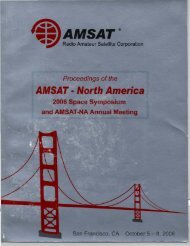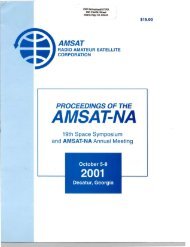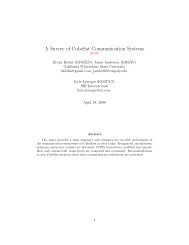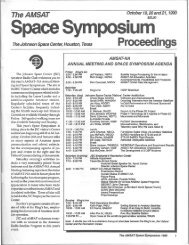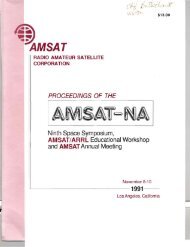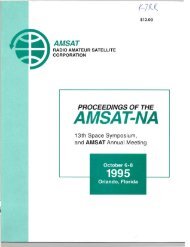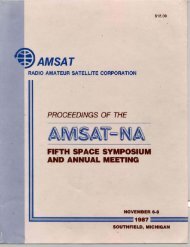October 27-29, 2000 - Klofas.com
October 27-29, 2000 - Klofas.com
October 27-29, 2000 - Klofas.com
Create successful ePaper yourself
Turn your PDF publications into a flip-book with our unique Google optimized e-Paper software.
The Cal Poly team is currently working on the development of a solar powered CubeS at. Using the latest solar cell<br />
technology, body-mounted solar panels should provide around I W of continuous power to the spacecraft. A solar<br />
powered CubeSat would require a much smaller battery and an additional 0.2 to 0.25 kg of payload could be<br />
incorporated. New <strong>com</strong>ponents that are currently being considered are a more powerful <strong>com</strong>puter with more storage<br />
capacity, a small CCD camera and a small magnet to provide some attitude control capabilities, in addition the Cal<br />
Poly team is seeking <strong>com</strong>mercial payloads to be flown in future CubeSat missions.<br />
4. LAllNCH OPPORTUNITIES AND COSTS<br />
The launcher tube, P-POD, being developed by Cal Poly to hold three CubeSats is designed to be attached to many<br />
different launch vehicles. The P-POD launcher will be rectangular tube about 4.5 inches square by 15 inches long<br />
and weigh about 5 kg. It would require only a small power activation signal from the last stage of the launch vehicle<br />
to activate the release mechanism and open the launcher door to release the CubeSats. Since the launcher<br />
<strong>com</strong>pletely contains the picosatellites, can be attached in a very small space and is lightweight, many launch<br />
vehicles can ac<strong>com</strong>modate this secondary payload. Multiple P-PODs could be attached to one launch vehicle for<br />
secondary payloads.<br />
There are several flight opportunities for CubeSats in the near future. Two launch opportunities are now available<br />
from with Thiokol Corporation in a joint Venture with Kosmotras on the converted Russian SS-18 called the Dnepr<br />
from the Russian launch site at Baikonour. The fIrst flight is scheduled for late 2001 which as many as 18 CubeSats<br />
are proposed to be launched from it. The cost for this launch is now established at $30,000/CubeSat. These<br />
opportunities are being coordinated through One Stop Satellite Services in Ogden, Utah. It is expected that these<br />
flights will continue to occur at least twice a year.<br />
The Aerospace Corporation, which was a partner on the OPAL projected and provided picosats for launch on that<br />
mission, is continuing picosat development with launches on the OSP-II (second Minotaur) from Vandenberg AFB,<br />
CA in 2001. Additional US launch opportunities are quite likely on many Boeing and Lockheed Martin launch<br />
vehicles.<br />
The Air Force OSP-III (third Minotaur) in now scheduled for launch in late 2002, which may have possible CubeSat<br />
launch opportunities.<br />
4.1 Launch Costs and Procedure<br />
The estimated launch cost per CubeS at that weights one kilogram or less is $30,000. This is based on the known<br />
launch and integration cost using the Kosmotras Dnepr. The present arrangements being made for launches on the<br />
Dnepr is a collaborative effort between Stanford University, Cal Poly and One Stop Satellite Services in Ogden,<br />
Utah. Contractual arrangements will be made with Stanford University; Cal Poly will provide P-POD test fIxture to<br />
the customer, provide the flight P-POD, integrate the CubeSat into the P-POD upon delivery to Cal Poly at San Luis<br />
Obispo, CA, perform fmal thermal and vacuum testing; then the P-POD will be shipped to One Stop Satellite<br />
Services at Ogden, Utah. One Stop Satellite Services will then be responsible for all export licensing, shipping to<br />
Kosmotras and integration onto the Dnepr.<br />
5. USE OF AMATEUR FREQUENCY CONSIDERATIONS<br />
Since is seems that the CubeSat cost ofdevelopment and costs of launching being lower than any other opportunities<br />
and within the budget for universities and ham radio clubs many CubeSats may be launched in the near future.<br />
With the launching of many ofthese CubeSats, a major issue is the frequency bands allocated for their use. There<br />
are several options that can be considered.<br />
1. The educational institution and ham radio clubs could use the amateur frequency bands, in particular the<br />
VHF and UHF bands.<br />
35



